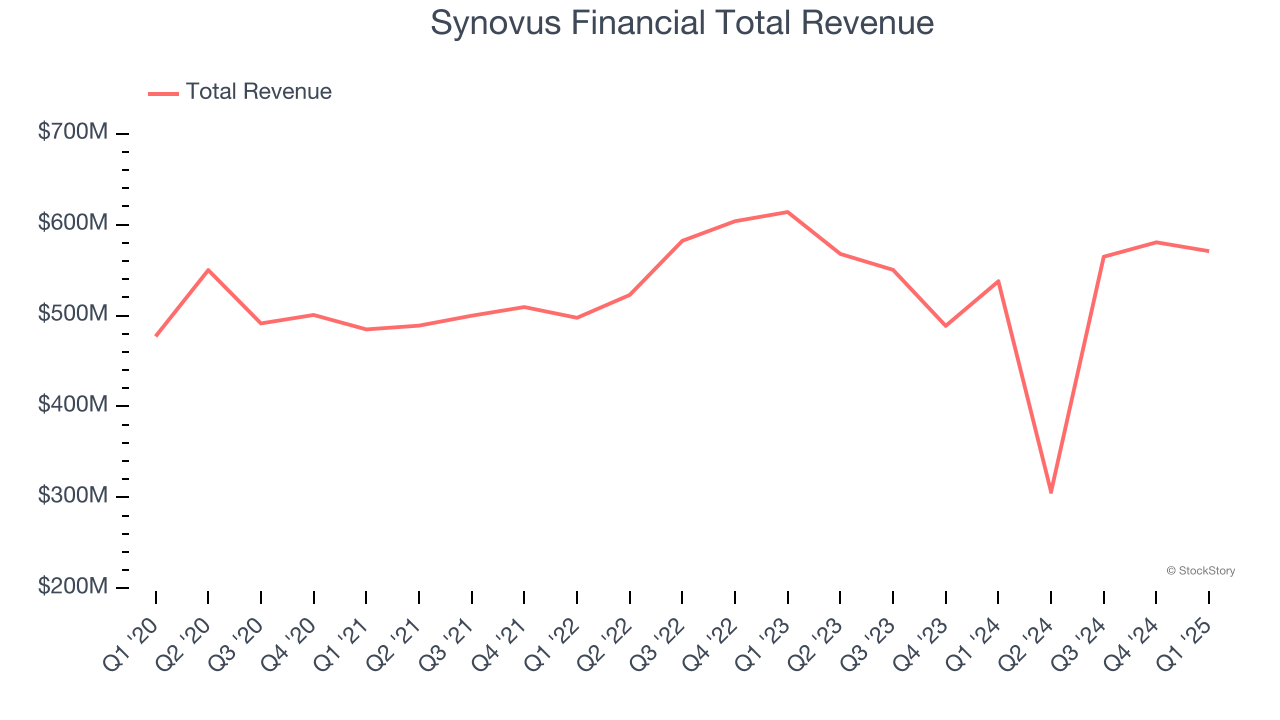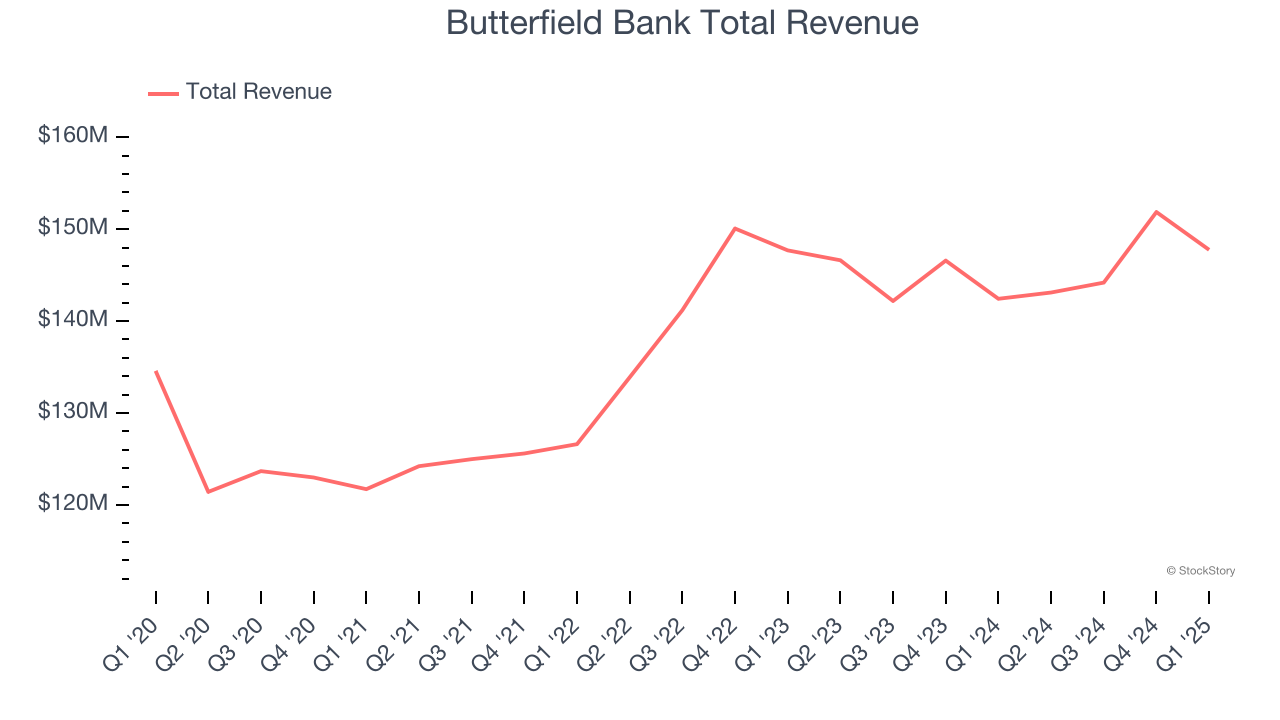
Earnings results often indicate what direction a company will take in the months ahead. With Q1 behind us, let’s have a look at Synovus Financial (NYSE:SNV) and its peers.
Regional banks, financial institutions operating within specific geographic areas, serve as intermediaries between local depositors and borrowers. They benefit from rising interest rates that improve net interest margins (the difference between loan yields and deposit costs), digital transformation reducing operational expenses, and local economic growth driving loan demand. However, these banks face headwinds from fintech competition, deposit outflows to higher-yielding alternatives, credit deterioration (increasing loan defaults) during economic slowdowns, and regulatory compliance costs. Recent concerns about regional bank stability following high-profile failures and significant commercial real estate exposure present additional challenges.
The 105 regional banks stocks we track reported a mixed Q1. As a group, revenues missed analysts’ consensus estimates by 1.6%.
Luckily, regional banks stocks have performed well with share prices up 13.6% on average since the latest earnings results.
Synovus Financial (NYSE:SNV)
Tracing its roots back to 1888 when a worker accidentally dropped a textile mill payroll into the dust, prompting the need for better banking, Synovus Financial (NYSE:SNV) is a regional financial services company that provides commercial and consumer banking, wealth management, and specialized lending services across five southeastern states.
Synovus Financial reported revenues of $570.9 million, up 6.2% year on year. This print was in line with analysts’ expectations, and overall, it was a very strong quarter for the company with an impressive beat of analysts’ EPS estimates and a solid beat of analysts’ net interest income estimates.
"In the first quarter, we delivered 67% year-over-year earnings per share growth, fueled by net interest margin expansion, a lower provision for credit losses and excellent expense management. We also continued to build momentum, as funded loan production was at the highest level since the fourth quarter of 2022, and our credit losses declined to the lowest level in more than three years. As the quarter progressed, borrowers and investors grew more cautious amid concerns surrounding the sustainability of consumer spending and potential impacts from higher tariffs and federal government layoffs. While the economic outlook and interest rate environment remains uncertain, we’re confident in our trajectory and the strength and resilience of our balance sheet and business model, as evidenced by our updated guidance for the year," said Synovus Chairman, CEO and President Kevin Blair.

Interestingly, the stock is up 10.9% since reporting and currently trades at $54.92.
Is now the time to buy Synovus Financial? Access our full analysis of the earnings results here, it’s free.
Best Q1: Butterfield Bank (NYSE:NTB)
Founded in 1784 as one of the oldest banks in the Western Hemisphere, Butterfield Bank (NYSE:NTB) provides banking, wealth management, and trust services to individuals and businesses in select offshore financial centers including Bermuda, Cayman Islands, and the Channel Islands.
Butterfield Bank reported revenues of $147.8 million, up 3.7% year on year, outperforming analysts’ expectations by 4.4%. The business had a stunning quarter with a solid beat of analysts’ net interest income estimates and an impressive beat of analysts’ EPS estimates.

The market seems happy with the results as the stock is up 8.6% since reporting. It currently trades at $46.05.
Is now the time to buy Butterfield Bank? Access our full analysis of the earnings results here, it’s free.
Weakest Q1: Triumph Financial (NASDAQ:TFIN)
Originally focused on traditional banking before pivoting to serve the transportation sector, Triumph Financial (NASDAQ:TFIN) provides specialized financial services to the trucking industry, including payments processing, factoring, banking, and data intelligence solutions.
Triumph Financial reported revenues of $100.8 million, flat year on year, falling short of analysts’ expectations by 3.8%. It was a disappointing quarter as it posted a significant miss of analysts’ tangible book value per share estimates and a significant miss of analysts’ net interest income estimates.
Interestingly, the stock is up 28.7% since the results and currently trades at $64.12.
Read our full analysis of Triumph Financial’s results here.
Renasant (NYSE:RNST)
Founded in 1904 during a time when the South was rebuilding its economy, Renasant (NYSE:RNST) is a regional bank holding company that offers banking, wealth management, insurance, and specialized lending services throughout the Southeast.
Renasant reported revenues of $170.6 million, up 4.2% year on year. This number surpassed analysts’ expectations by 1.9%. Taking a step back, it was a satisfactory quarter as it also logged a narrow beat of analysts’ tangible book value per share estimates but net interest income in line with analysts’ estimates.
The stock is up 32.1% since reporting and currently trades at $37.87.
Read our full, actionable report on Renasant here, it’s free.
First Hawaiian Bank (NASDAQ:FHB)
Dating back to 1858 as Hawaii's oldest bank with deep roots in the Pacific island communities, First Hawaiian (NASDAQ:FHB) operates a full-service community bank providing deposit accounts, commercial and consumer loans, credit cards, and wealth management services across Hawaii, Guam, and Saipan.
First Hawaiian Bank reported revenues of $211 million, up 2.5% year on year. This print beat analysts’ expectations by 0.6%. Zooming out, it was a mixed quarter as it also produced a narrow beat of analysts’ net interest income estimates but EPS in line with analysts’ estimates.
The stock is up 13.4% since reporting and currently trades at $26.43.
Read our full, actionable report on First Hawaiian Bank here, it’s free.
Market Update
As a result of the Fed’s rate hikes in 2022 and 2023, inflation has come down from frothy levels post-pandemic. The general rise in the price of goods and services is trending towards the Fed’s 2% goal as of late, which is good news. The higher rates that fought inflation also didn't slow economic activity enough to catalyze a recession. So far, soft landing. This, combined with recent rate cuts (half a percent in September 2024 and a quarter percent in November 2024) have led to strong stock market performance in 2024. The icing on the cake for 2024 returns was Donald Trump’s victory in the U.S. Presidential Election in early November, sending major indices to all-time highs in the week following the election. Still, debates around the health of the economy and the impact of potential tariffs and corporate tax cuts remain, leaving much uncertainty around 2025.
Want to invest in winners with rock-solid fundamentals? Check out our Hidden Gem Stocks and add them to your watchlist. These companies are poised for growth regardless of the political or macroeconomic climate.
StockStory is growing and hiring equity analyst and marketing roles. Are you a 0 to 1 builder passionate about the markets and AI? See the open roles here.
